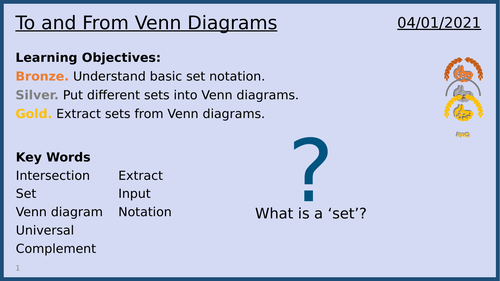

This lesson titled ‘To and From Venn Diagrams’ is fully differentiated, and uses whiteboard questions as a scaffolding and Assessment for Learning method.
These whiteboard questions are also particularly useful for reducing students’ maths anxiety by providing them with multiple answer they can choose from. All of the whiteboard questions have diagnostic-style wrong answers, obtained from common misconceptions
The title of the lesson is throughout the PowerPoint. This provides consistency throughout, allows students to catch up if they missed it, and takes late-comers into consideration. The date is also throughout the PowerPoint and updates automatically. This is done so that the students know exactly where it is each lesson, and to make it easier on the class teacher.
A dyslexic-friendly font (Verdana) is used throughout the PowerPoint and any worksheets.
Worksheets are embedded in the PowerPoint on the slides to which they relate.
Animated answers to all questions are provided where possible.
The learning objectives are designed to be as short sentences as possible to allow students to read them and write them down (if necessary) as quickly as possible. They also use a mixture of simplistic and specialised words to engages students’ thinking about definitions whilst allowing them to access the meaning of the sentences. These objectives are reviewed at the end of the lesson as a self-evaluation of learning technique. Students are awarded ‘brain’ medals depending on how well they have done.
These are kept as simple as possible and broken down carefully. This is to encourage students to access the material whilst giving them the confidence by achieving something in the lesson.
B) Understand basic set notation.
S) Put different sets into Venn diagrams.
G) Extract sets from Venn diagrams.
If you like the resource, please leave a review. If you didn’t please leave one anyway with any suggestions on how I could improve it.
Whilst this lesson is part of a larger bundle, and does link nicely with some of the other lessons, it can certainly be used independently as well.
Something went wrong, please try again later.
This resource hasn't been reviewed yet
To ensure quality for our reviews, only customers who have purchased this resource can review it
Report this resourceto let us know if it violates our terms and conditions.
Our customer service team will review your report and will be in touch.